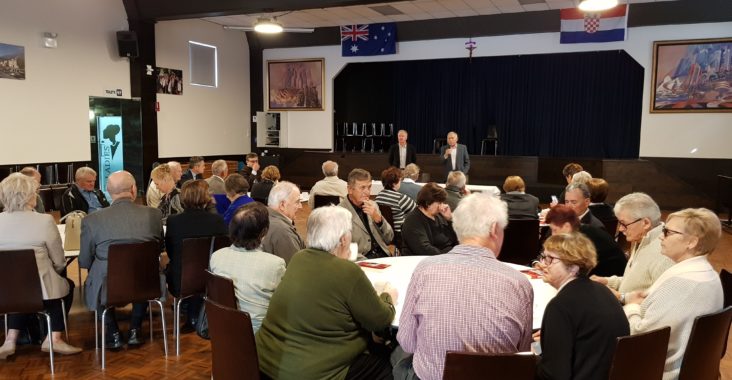Four decades on from the (alleged) events of February 8, 1979, a dark stain remains on the Australian criminal justice system. It involves police, prosecutors, trial judges, jurors and appeal courts — all the way to the High Court. Along with intelligence agencies, senior public servants and leading politicians.In Britain it has been accepted that the accused in the Birmingham Six an
Guildford Four cases were wrongly convicted of the Irish Republican Army terrorist attacks that took place in these cities in 1974. However, Australia’s Croatian Six case of 1979 remains extant — in the face of evidence that a serious miscarriage of justice took place in this instance.
The facts are set out in the new book Reasonable Doubt: Spies, Police and the Croatian Six (Doosra Media) by freelance journalist Hamish McDonald.On February 8, 1979, Vico Virkez, who claimed to be a Croatian Australian, phoned the Yugoslav consulate in Sydney advising that several of his colleagues were planning terrorist attacks in Sydney. Virkez lived in Lithgow, NSW, at the time.Enter Roger Rogerson, the now notorious ex-policeman and convicted murderer. Acting on Virkez’s warning, passed on by the consulate, Rogerson led a NSW police raid on a house in the Sydney suburb of Burwood, where several Croatian Australians were arrested for conspiracy to commit terrorism.
There were other raids and charges were laid against Max Bebic, Vic Brajkovic, Mile Nekic, Ilija Kokotovic, Joe Kokotovic and Tony Zvirotic: the Croatian Six.
In 1979, Croatia was part of the federation of Yugoslavia, which included Serbia, Slovenia, Macedonia, Montenegro and Bosnia and Herzegovina. The nation was a brutal communist dictatorship led by Josip Broz Tito, who presided over a highly efficient secret police — the UDBA. Most Croatians were Catholic and vehemently anti-communist. Many Croatian Australians opposed Tito and his government.

In the late 1960s and into the 70s, there were several attacks on Yugoslav properties in Australia, most of which resulted in very little damage. ASIO was of the view that many, if not all, of these attacks were false-flag operations, meaning they were undertaken by UDBA agents in Australia in an effort to discredit Croatian Australians who opposed the Tito regime.
This was not the view of the Labor Party, which was in opposition until Gough Whitlam led it to an election victory over William McMahon’s Coalition in December 1972. In the lead-up to the change of government, the left wing of Labor, led by Lionel Murphy and Jim Cairns, clashed with the Coalition’s attorney-general Ivor Greenwood over the matter.
Not long after the Whitlam government came to office, Murphy, who had been named attorney-general, led a raid on the ASIO office in Canberra and its national headquarters in Melbourne. He was convinced ASIO was covering up Croatian terrorism in Australia.
It wasn’t — and Murphy’s political career was effectively ended. He was appointed by Whitlam to the High Court in 1974.
As historian Paul Collins has written, there has been a strain of anti-Catholic sectarianism in Australia since European settlement in 1788.

There was hostility to the Croatians from the Left. After all, they were anti-communist as well as Catholic. Some continuing admirers of Murphy, such ABC television’s Q&A presenter Tony Jones, still hold the view that there were “Catholic Croatian extremists” engaged in multiple bombings in Australia in the 70s.
This is the thesis of Jones’s part fact/part fiction book The Twentieth Man (which I reviewed in The Sydney Institute Review online in January last year). Jones has not been able to name a single “Catholic Croatian extremist” who engaged in bombings in Australia at the time.
The Jones position of today was relatively widespread four decades ago. The Croatian Six were convicted after a 10-month trial, following which the jury deliberated for 68 hours. The primary evidence against them consisted of their confessions, all of which were unsigned. It was not uncommon for NSW police at the time to verbal the accused and construct interviews.
All six denied that they had made the statements.
In his book, McDonald makes a convincing case that the trial judge, Alan Victor Maxwell, was hostile to the accused. Moreover, when the case went on appeal to the NSW Court of Criminal Appeal, the senior judge, Gordon Samuels, happened to be one of Maxwell’s closest friends. All three appeal judges dismissed the case. Subsequently, the High Court threw out the appeal to it in about 10 minutes.
Towards the end of the trial, defence counsel suggested that Virkez, the primary witness for the prosecution, was a Serb rather than a Croat. This was consistent with the view that the Croatian Six were framed by a UDBA false-flag operation. McDonald, following research in ASIO and National Archives files, makes a convincing case that this fact was known to the NSW Police Force and some senior public servants in Canberra, who deliberately withheld this information from defence counsel during the trial.
In 1989, after serving 10 years of maximum 15-year sentences, the Croatian Six were released from prison. Two years later, ABC TV Four Corners presenter Chris Masters interviewed Virkez, who had returned to Yugoslavia a decade earlier. Virkez told Masters that he was not a Croat and had given false evidence at the trial. That’s nearly 30 years ago.
John Blaxland and Rhys Crawley wrote The Secret Cold War in 2016; it’s the third volume of ASIO’s official history. The authors concluded that the Croatian Six had experienced a “wrongful conviction”. John Schindler, formerly with the US National Security Agency, regards the conviction of the Croatian Six as probably the most successful agent provocateur operation by Tito’s secret police.
There have been various attempts through the years to correct this wrong. The evidence suggests that Labor as well as Coalition governments in Canberra and Sydney have failed to properly address the evident injustice. But it’s not too late for the victims of the miscarriage of justice and their families. And it’s high time that Australia’s legal and governmental system admitted to the errors that led to the persecution of the Croatian Six.
Gerard Henderson is executive director of the Sydney Institute. His Media Watch Dog blog can be found at theaustralian.com.au.
This article was originally published in the Australian daily newspaper. Gerard Henderson is executive director of the Sydney Institute. His Media Watch Dog blog can be found at theaustralian.com.au.




Komentari